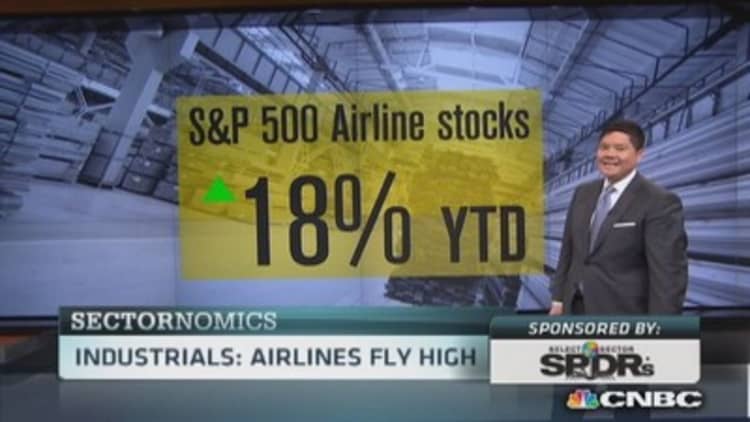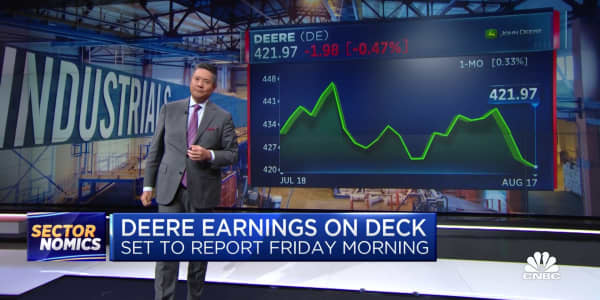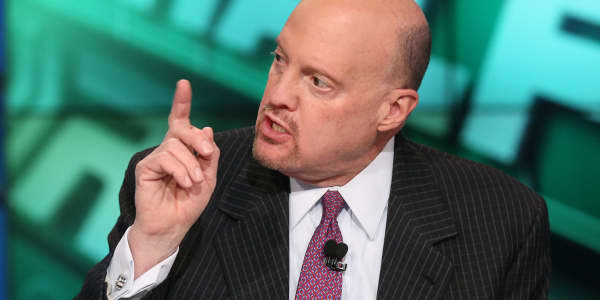
Call airlines the Wile E. Coyote of the stock market: Come along pretty much anytime the economy is beginning to cool off and you'll find bloated fleets, too many scheduled flights and planes flying at a capacity too low to make money—right before the bottom drops out.
When Warren Buffett became just one more investor to lose money on an airline stock—a 1989 misadventure in US Airways—it was notable mostly for Buffett's joke that if a farsighted capitalist had been at Kitty Hawk in 1903, he would have shot down Orville Wright's plane. And that's just one of the many choice phrases Buffett has used over the years to caution investors about airline stocks.
So it may come as some surprise to Buffett and other investors that at the front of the market rally of the last 15 months is the much-maligned airline sector.
The NYSE ARCA Airline Index is up 80 percent since the end of 2012, crushing the S&P 500's perfectly healthy 29 percent gain. The airline stock rally includes a 15 percent jump in airlines as the broader market cooled off in early 2014.
Can the rally last?
"The cycle can continue for a long way,'' said Stifel Nicolaus airline analyst Joseph DeNardi. "Airlines are being disciplined. That will lead to pretty strong pricing, and that will lead to earnings growth."
Last year every major U.S. airline made money—only United had a money-losing quarter.
The case for airline stocks is about three C's: consolidation, capacity discipline, and an economic comeback.
Read MoreHawaiian Airlines riding growth wave
Planes are running more than 83 percent full—last year sported the highest yearlong "load factor" since World War II, and if the U.S. economy keeps improving, that airline metric will go up as well. Ticket prices are rising faster than inflation, and the price of jet fuel is behaving—spot prices have stayed between $2.80 and $3 per gallon for the last year and are no higher than in 2008. Even the industry's stubbornly high labor costs have been ratcheted down, with fixed costs converted to profit-sharing plans in talks influenced by the threat, or the fact, of bankruptcy.
Arguably best of all, there are only four major U.S. carriers left after a wave of mergers and bankruptcies. The Big Four control 87 percent of the U.S. market, according to U.S. Department of Transportation data. American and US Airways are merging, the United Continental hookup occurred in 2010, Delta took over Northwest the same year, and Southwest consolidated its grip on lower-end flyers by merging with AirTran.
There is much less competition than there used to be, because there are almost no start-up carriers competing directly for passengers with the big trunk airlines, said Barclays analyst David Fintzen. And the low-cost carriers that are flying, including Allegiant and Spirit Airlines, are just as profit-focused as the big boys.
"There isn't a competitor out there who's trying to take market share at the expense of making money,'' DeNardi said.
This means fare wars are rare, and even when they happen, they are much more muted than historically. Consider the fight between Delta and respected niche carrier Alaska Air for the top spot in the Seattle market, where Alaska makes its hub. Look for a midweek Los Angeles–Seattle round-trip in early May, and the fare on a route popular with business flyers is $198—the same on each airline—and it is likely to move higher, according to kayak.com. Tellingly, the fare is no lower on the following weekend, when airlines once would have slashed fares to lure budget-conscious leisure travelers.
It used to be that when you had more competition, you couldn't keep degrading service and increasing fares.Paul Hudsonpresident of FlyersRights.org
The lack of competition is also helping airlines get away with new service charges that are creating a new model for the industry, even if customers are less enthused. The major U.S. airlines raked in $6 billion of checked-bag fees, flight-change fees and other ancillary revenue last year, up from $1.4 billion in 2007 and more than the $5.5 billion that the International Air Transport Association estimates U.S. carriers made in net profit. Of the major airlines, only Southwest doesn't routinely charge $20 or more per bag, and ticket-change fees have soared as high as $200.
"It used to be that when you had more competition, you couldn't keep degrading service and increasing fares," said Paul Hudson, president of FlyersRights.org in Sarasota, Fla. "Seat space is shrinking; leg room is shrinking. It's hard to find a passenger who thinks service has gotten better.''
With no new version of JetBlue or PeopleExpress arising to disrupt the status quo in the skies, there is an industrywide focus on profitability and cash flow that was remarkably little in evidence industrywide in past cycles.
The most profitable have been niche carriers and deep discounters. Alaska Air had an EBITDAR (EBITDA + airplane rentals) margin of 20.7 percent in 2013 and it is forecast to reach 22.7 percent this year, according to Stifel. Spirit earned 29.3 percent on each dollar of sales in 2013 and is projected to hit 30.6 percent this year. At the Big Four, this profit metric ranges on average from 11.5 percent to 15 percent on each dollar—Delta was at 14.1 percent last year and is projected by Stifel to reach 15.9 percent this year.
Top 10 airline stocks year-to-date 2014 performance
| Ticker | Company | % Change 2014 |
|---|---|---|
| AAL | American Airlines Group Inc. | 33.5 |
| HA | Hawaiian Holdings Inc. | 32.9 |
| ALK | Alaska Air Group Inc. | 22.5 |
| GOL | GOL Linhas Aereas Inteligentes S.A. Sponsored ADR | 21.7 |
| LUV | Southwest Airlines Co. | 21.5 |
| SAVE | Spirit Airlines Inc. | 21.3 |
| RYAAY | Ryanair Holdings Plc Sponsored ADR | 19.6 |
| DAL | Delta Air Lines Inc. | 16.2 |
| UAL | United Continental Holdings Inc. | 11 |
| ALGT | Allegiant Travel Company | 7.6 |
Source: Source: CNBC data (through 4/15)
The new profit focus means airlines are not going wild on buying new planes. Growing the number of available seats too fast has historically been the biggest way airlines get in trouble—they borrow money to buy new planes; then they get caught in a recession with too much debt. Even after several years of whittling down debt loads, major carriers carried a combined $71.5 billion in debt at year-end 2013, according to industry trade group Airlines for America.
In 2002, airlines added seats in a slowly recovering economy at a double-digit annual rate in some months of the year. Contrast that with today's environment, with top carriers deliberately not adding seat-miles faster than real gross domestic product grows—2 percent to 3 percent a year. Delta is targeting 0 percent to 2 percent capacity growth this year; United is at 1 percent to 2 percent; Southwest expects capacity to be "relatively flat.'"
"We're seeing some nice rationality in capacity and in fares in the markets," Spirit's vice president of pricing and revenue management, Graham Parker, told analysts in February. "And we're seeing a very similar environment to 2013."
Top 10 airline stocks 2013 performance
| Ticker | Company | % Change 2014 |
|---|---|---|
| SAVE | Spirit Airlines Inc. | 156.1 |
| DAL | Delta Air Lines Inc. | 131.4 |
| RJET | Republic Airways Holdings Inc. | 88.2 |
| LUV | Southwest Airlines Co. | 84 |
| ALK | Alaska Air Group Inc. | 70.3 |
| UAL | United Continental Holdings Inc. | 61.8 |
| CPA | Copa Holdings S.A. Class A | 61 |
| JBLU | JetBlue Airways Corporation | 49.3 |
| HA | Hawaiian Holdings Inc. | 46.6 |
| ALGT | Allegiant Travel Company | 43.6 |
Source: Source: CNBC data (through 4/15)
All this cost control will give the airlines more operating leverage if the economy continues to improve. U.S. business travel will grow 6.6 percent this year to $290 billion, with a 12.5 percent jump in U.S.-originated international travel, according to the Global Business Travel Association.
"Capacity discipline drives margins,'' Fintzen said. "If you enjoyed $79 airfares in 2004, that wasn't going to be sustainable."
Delta and Spirit are the top picks on Wall Street, based on Thomson Reuters data on average number of analyst buy ratings. Spirit is the growth story, with analysts expecting 2014 sales to climb nearly 18 percent and operating profit up by about the same amount. The stock trades at 20 times this year's expected earnings—steep for an airline. Delta's calling card is management and cost control: It has done the most complete job of integrating its recent merger, and its stock trades at about 13 times this year's expected profits.
I don't think everyone has bought into the idea that this time is different.Joseph DeNardiStifel analyst

There are holes in the thesis. While Fintzen is bullish on the idea that bigger dividends and stock buybacks can boost shareholder returns, every major U.S. airline pays a lower yield than the S&P 500 average of 1.96 percent. And the reliance on baggage and ticket-change fees is a potential vulnerability. As a group, airlines would be losing money without them, even with planes flying almost as full as they can get.
Read MoreFaster Wi-Fi on flights leads to new battle in the sky
In fact, the NYSE ARCA Airline Index is trading at less than half of the level it was when the index was launched in the 1990s, because of investor skepticism that the good times can ever last for airline stocks. "I don't think everyone has bought into the idea that this time is different,'' DeNardi said. "If you see airlines adding capacity faster than [the economy] grows, that would be the red flag."
Things could get a little bumpy
Airlines have finally shown some weakness amid the broad market selloff, with American, Delta and United down more than 10 percent from recent highs. At least some of that selling is likely related to hedge funds cashing in on profitable positions to cover losses rather than a valuation call on the airline stocks themselves.
CNBC's Bob Pisani recently explained, "The margin debt of these funds is very high, so when they are under pressure, they need to sell their most stable and profitable positions to cover losses and, possibly, margin calls. Guess what those positions are? Yep. Airlines."
The Stifel analyst expected some degree of choppiness going into the quarter given the adverse weather earlier in the year, but said the degree of underperformance has been somewhat surprising. "We're still bullish longer-term on the industry—particularly Delta, Spirit, United, and Allegiant," he wrote in an email. The next key data point will be first quarter earnings and the commentary provided regarding demand and pricing trends going into the summer, which Stifel expects to remain healthy.
Airline stocks remain a well-timed buy rather than a buy-and-hold sector by nature. DeNardi said it's a calculated bet on the newly restrained competition, an increasingly solid recovery and the airlines' ability to wring extra revenue from already-scheduled flights. Would-be start-up airlines are unable to find backers, fares are rising, and a new stream of fee revenue, even if unpopular, all add up to another 20 percent appreciation for the recently profitable airline stocks—and maybe even more lift, Fintzen said.
"We would be buyers on any sell-off associated with 1Q EPS softness attributed to the weather or other non-recurring items as long as the longer-term demand environment remains healthy," DeNardi said.





